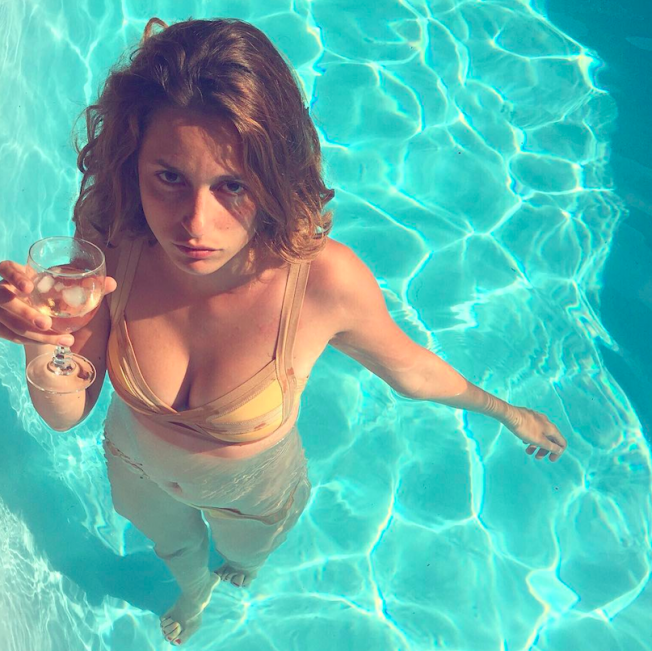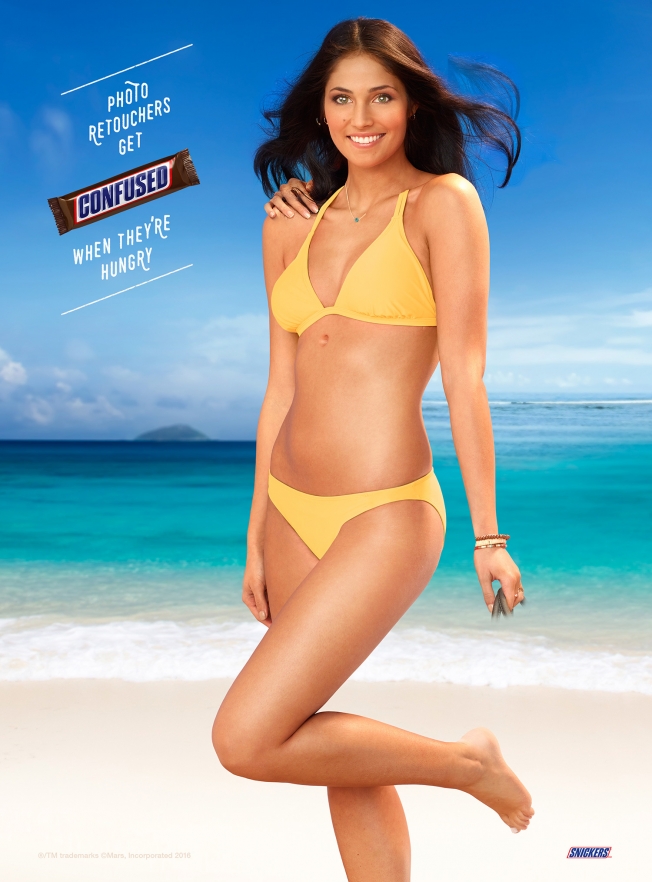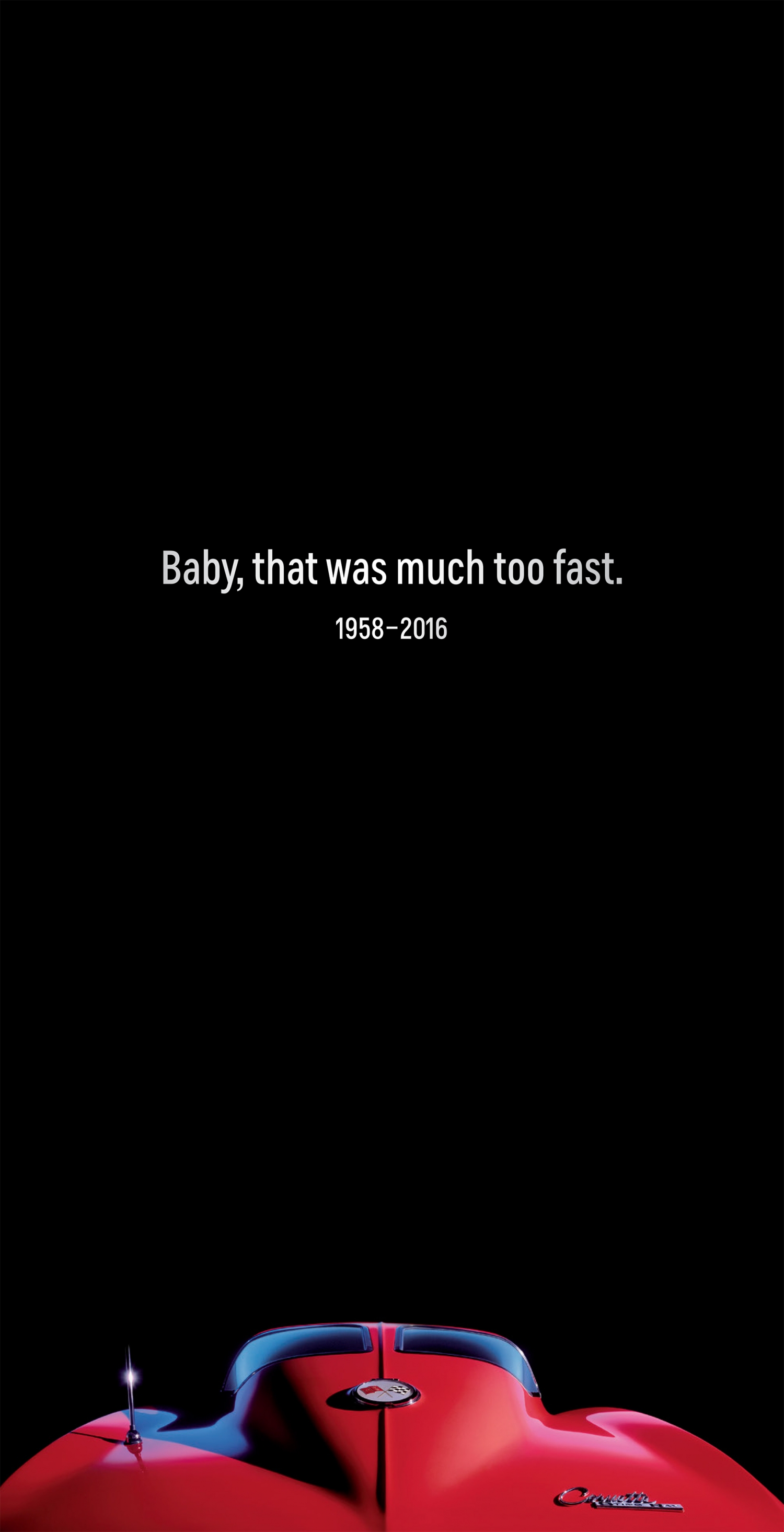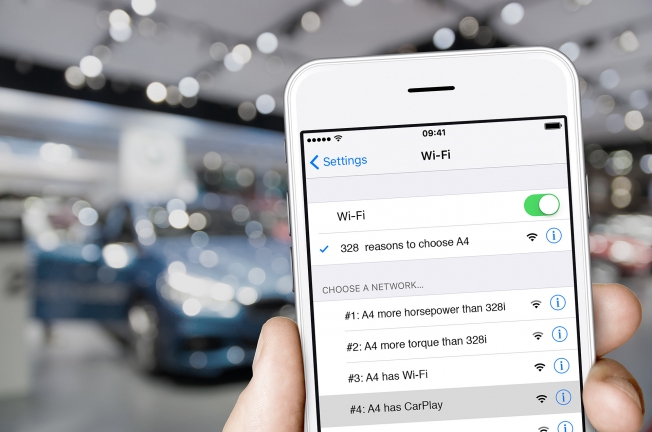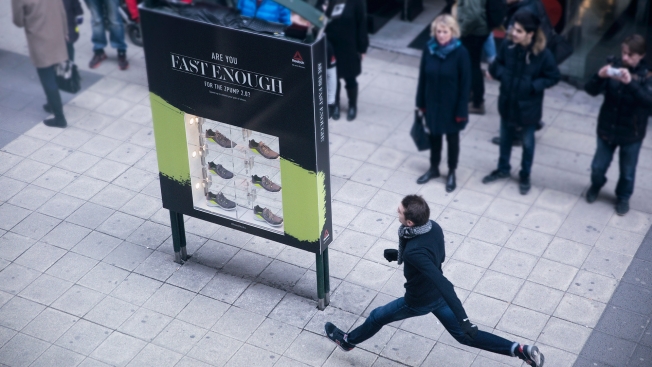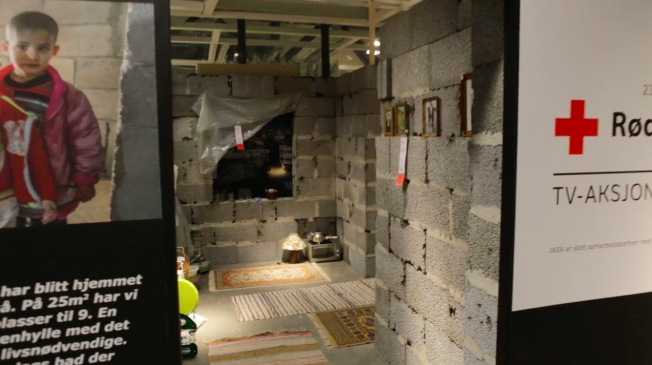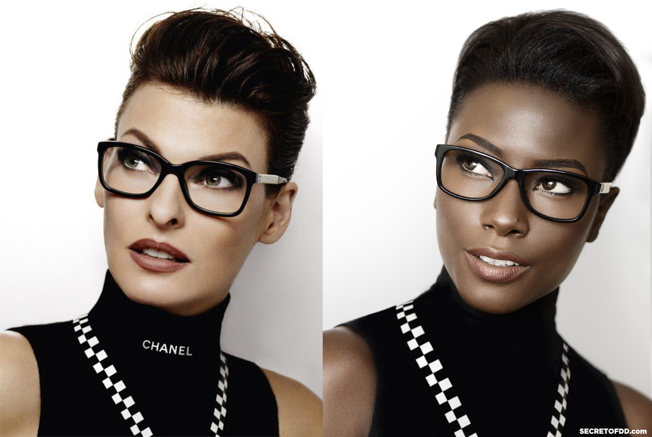![]()
Out-of-home remains one of our favorite advertising mediums. Yes, so much of it is an eyesore, but when it's great, there's almost nothing better. There's something particularly delightful about great work that lives in the physical world and not on a screen. The best outdoor work is immediate, visceral, instantly relevant—and just real—in ways advertising always strives to be.
This gallery of great outdoor advertising from 2016 has executions that are all over the map, literally and figuratively. We travel from the U.S. to Canada to France to Australia to find great ideas delivered in clever, thoughtful and often hilarious ways. Each piece of work generated an enormous reaction—a good reminder that in the age of the internet, even single executions can have global reach.
Congrats to all the brands and agencies on the list.
16. Patricia Houlihan Shoots Lasers Out of Her Eyes
Agency: Immersion Creative, Vancouver
We'll start off with a goofy one, but it's too good to pass up. Patricia Houlihan, a real estate agent in Vancouver, put up a single bus-stop advertisement in Burnaby, B.C. Before long, it was on the front page of Reddit. The brilliantly campy creation was made by Mike Catherall, creative director at Immersion Creative. He'd been trying to get Houlihan to run it for years. Catherall told Adweek earlier this year: "I dug up that campaign from the archives. I said, "What do you think, should we give this a shot?' She always thought it was kind of funny, so we were like, 'Sure, why not?' What I love about it is that it is irreverent, fun and totally different than the literally hundreds of realtor ads in Vancouver at the moment that are all so boring and cliché." Mission accomplished.
![]()
15. Audi - Wifi Jack
Agency: Muh-tay-zik Hof-fer, San Francisco
Audi hit the New York Auto Show in March with an insidiously clever tech hack. It set up a bunch of free Wi-Fi networks—Wi-Fi is hard to find at auto shows, and usually password protected—and gave them names that doubled as ads for the A4 (and as attack ads on BMW's 328i as well). The stunt was "a modern version of challenger advertising, where a superior product takes on the old standard," Matejczyk told Adweek. "And marketing being what it is these days, why not offer a really helpful service in the process?"
![]()
14. Reebok - Are You Fast Enough?
Agency: Animal, Stockholm
Back in February in Stockholm, Reebok put up an outdoor ad equipped with a built-in speed cam and tracking technology to measure pedestrians' pace. Anyone who ran past the ad faster than 17 kilometers per hour (about 10.5 miles per hour) unlocked a brand new pair of ZPump 2.0 shoes. "We really like the idea of taking a classic billboard and turning it into something disruptive and unique," said Markus Schramm, creative at ad agency Animal.
![]()
13. Glimpse Collective - #CatsNotAds
Agency: Glimpse Collective, London
In May, a Kickstarter quietly popped up looking for donations to replace the entire ad inventory of one London Underground station with pictures of cats. By September, the dream was a reality. Commuters passing through the Clapham Common Tube station were met by feline friends."We tried to imagine a world where public spaces made you feel good. We hope people will enjoy being in the station and maybe think a bit differently about the world around them," Glimpse founder and #CatsNotAds leader James Turner said. "Instead of asking you to buy something, we're asking you to think about what's really valuable in your life. It might not be cats, but it's probably something you can't find in the shops."
![]()
12. Bonds - The answer, my friends, is blowing in the wind
Agency: Clemenger BBDO, Melbourne
Australian underwear brand Bonds had a big hit in 2015 with "The Boys," a video campaign starring a couple of talking testicles. In 2016, they took the campaign outdoors with a seven-story-high weather billboard in downtown Melbourne, on which the lads reacted in real time to cold, warmth and wind. In cold weather, the boys shrank toward the top of the billboard. In warm weather, they descended and hung freely. They got swung about whenever the wind blew, too. "While we pioneered a technology more than two years ago to serve up advertising based on average temperatures, this campaign takes it to a whole new level using live RSS feeds," said oOh! media CEO Brendon Cook.
11. Ikea - 25 Square Meters
Agency: POL, Oslo
Those shopping for the comforts of home at an Ikea in Norway were confronted firsthand with the difficult living conditions in Syria. Next to its typical showrooms, Ikea built a replica of a real Syrian home—25 square meters of cinder block walls and meager furnishings. Furniture tags asked for Red Cross donations. "We already had a lot of [video] footage from within Syria, but no matter how emotional it was, nothing got close to the experience of visiting people in a war zone," POL art director Snorre Martinsen told Adweek. "Placing a Syrian home next to all the Scandinavian homes was obviously a brave move from the warehouse, but it made it clearer than any TV commercial how crucial it is to donate and help."
![]()
10. Elevation Pictures - Snowden Billboard
Agency: DentsuBos, Toronto
To promote Oliver Stone's film Snowden, about the NSA whistleblower Edward Snowden, Elevation Pictures put up a billboard that spied on pedestrians in Toronto and streamed footage of their movements on the street. "It was very interesting seeing people's reactions," said Jon Frier, creative director at DentsuBos. "Some felt violated, some terrified, and some even praised it as the creepiest thing ever. Funnily, almost all looked around to see if there were other cameras spying on them. Which in itself is very telling."
9. MS - This Bike Has Multiple Sclerosis
Agency: Grey Australia
To raise awareness of multiple sclerosis ahead of the MS Melbourne Cycle in early March, Grey Australia came up with a brilliant idea for nonprofit MS—build a bike that would give riders the feeling of having the symptoms of the disease. Its gears are unpredictable, its frame off-balanced, and its brakes numb to press. Created by Carol Cooke, a cycling Paralympian, with a team of bike-building experts, it was a near-perfect way of showing people what it's like to live in an afflicted body, short of having the disease.
8. Transport Accident Commission - Graham
Agency: Clemenger BBDO, Melbourne
Technology has far outstripped humans' ability to evolve. Take the automobile, for example. Human bodies are not designed to travel that fast—or more to the point, to be able to handle accidents at that speed. Clemenger BBDO Melbourne and Australia's Transport Accident Commission dramatized this for a safe-driving campaign in a remarkable way—by teaming with artist Patricia Piccinini to create Graham, a human designed to withstand crash forces. His head is wide and flat, with a protruding forehead ... and he's got a lot of nipples. Graham was met with a lot of ridicule on the internet, but it's actually a brilliant campaign—delivering a weird and memorable visual that intrigued people worldwide and got them thinking about safe driving.
7. Kolcraft - The Contours Baby Stroller Test-Ride
Agency: FCB, Chicago
Moms and dads never know which stroller to buy, because they can't test them out themselves by riding in them. Well, problem solved. Kolcraft and FCB Chicago designed adult-size versions of its Contours stroller and invited grown-ups to take a test ride. "The problem with shopping for baby strollers is that babies can't tell you how they ride or feel, and parents can't fit into them," FCB Chicago chief creative officer Todd Tilford said at the time. "We solved the problem. Now parents can shop informed."
6. Volkswagen Trailer Assist - Backing Up a Trailer
Agency: Try, Oslo
A Volkswagen station wagon whips down a spiral parking lot ramp, around a traffic circle, and past slower-moving cars—all in reverse—while perplexed drivers and pedestrians look on, wondering what maniac is behind the wheel. This great stunt from agency Try in Oslo involved building a fake trailer that someone inside could drive forward, giving the appearance of a crazy person reversing. "Backing up with a trailer will be this easy," assures the copy in the ad, promoting the automaker's Trailer Assist function. "Well, almost."
5. Adidas - Odds
Agencies: Taproot Dentsu and Carat Media
Why should a blade-running athlete with only one foot—or anyone else—have to buy expensive athletic shoes for both feet? Adidas asked that question in this marvelous campaign, and actually sold two left shoes or two right shoes as pairs in India. "At Adidas we live a simple principle: No athlete left behind," said senior marketing director Damyant Singh of Adidas India. "This philosophy is at the heart of 'Odds by Adidas.' It is our way of encouraging and cheering para-athletes on to achieving their best on the field of play."
4. Burger King - Scariest BK
Agency: David, Miami
Burger King pulled off the year's best Halloween prank, dressing up a BK location in Queens, New York, as the ghost of McDonald's. That's a scary idea to BK regulars. The costume featured billowing white sheets and a sign that read: "Booooooo! Just kidding, we still flame grill our burgers. Happy Halloween."
3. McDonald's - The Directional Billboard
Agency: TBWA\Paris
McDonald's got the better of Burger King, though, with this brilliantly outlandish campaign in rural France. The small billboard said the nearest McDonald's drive-through was just 5 km ahead. But right next to it was a gigantic board that said the nearest BK was 258 km away—and hilariously gave directions for exactly how to get there.
2. Art Institute of Chicago - Van Gogh Bnb
Agency: Leo Burnett, Chicago
For sheer incredible craft, this Leo Burnett campaign was a world-beater in 2016. An Art Institute of Chicago exhibit brought together all three versions of Van Gogh's "The Bedroom" for the first time in North America. To commemorate it, Burnett worked with the museum and media agency Spark to build a full-scale, livable model of the work in a historical downtown Chicago building—and then rented it out for nights on Airbnb. "We thought the best way to help people understand Van Gogh's life was to invite them to spend a night in this room," said Burnett associate creative director Pete Lefebvre. "What better way to give people a glimpse into his mind than to create a truly immersive, one-of-a-kind experience like this?" Simply gorgeous work.
1. The Next Rembrandt
Agency: J. Walter Thompson Amsterdam
The most intriguing and exciting piece of outdoor advertising made in 2016 was a painting—a new Rembrandt, made 347 years after the last one. Or least, it was an incredible approximation of a Rembrandt, created as part of a fascinating artificial-intelligence-meets-creativity project by J. Walter Thompson Amsterdam for banking client ING.
The humans at JWT taught a computer to paint like Rembrandt by having it study the old master's works for months. The resulting painting was a completely new portrait, not a replica, indistinguishable to most people from the real thing. The connection to ING was somewhat peripheral, but the bank had sponsored Dutch arts and culture for a decade. And the artwork created a worldwide debate about humans' claim to creativity—to the glee of many technologists and the consternation of many art historians.
"People were asking, 'Is this good?' 'What's the relationship between artificial intelligence and creativity?' 'Is creativity flashes of genius that are reserved for mankind?' " JWT ecd Bas Korsten told Adweek. "Those questions have gotten a lot of attention from people in the art and tech worlds, who are actually quite opposed in their reactions."
A grand, ambitious idea and a stunning execution—congrats to ING and JWT for pulling off the year's greatest experiment in outdoor advertising.




